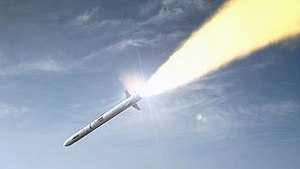Sea Ceptor
| CAMM | |
|---|---|

An MBDA computer generated graphic showing a CAMM missile in flight.
|
|
| Type |
CAMM: Short/medium range anti-aircraft and anti-missile missile. CAMM-ER: Medium range anti-aircraft and anti-missile missile. |
| Place of origin |
United Kingdom (CAMM) Italy (CAMM-ER) |
| Service history | |
| In service | 2016 |
| Production history | |
| Manufacturer |
MBDA UK (CAMM) MBDA Italy (CAMM-ER) |
| Specifications | |
| Weight |
CAMM: 99 kg CAMM-ER: 160 kg (<250 kg, missile with canister) |
| Length |
CAMM: 3.2 m CAMM-ER: 4.0 m (canister, 4,4 m) |
| Diameter |
CAMM: 166 mm CAMM-ER: 190 mm (canister, 27.5 × 27.5 cm) |
| Warhead | Directed fragmentation. |
|
Detonation
mechanism |
Contact or proximity. |
|
|
|
| Engine | Solid-fuel rocket motor. |
|
Operational
range |
CAMM: <1–25+ km CAMM-ER: <1–45+ km |
| Speed | Mach 3 (1,020 m/s) |
|
Guidance
system |
|
|
Launch
platform |
|
The CAMM (Common Anti-Air Modular Missile) series is a family of surface-to-air and air-to-air missiles developed by MBDA for the United Kingdom. CAMM shares some common features and components with the ASRAAM air-to-air missile, but with updated electronics and an active radar homing seeker. It is envisioned that the missile will be introduced into all three service branches of the British Armed Forces and is currently scheduled to enter service starting 2016. The Common Anti-Air Modular Missile is intended to replace the Sea Wolf missile on Type 23 frigates of the Royal Navy, the Rapier missile in British Army service and contribute to the eventual replacement of ASRAAM in service with the Royal Air Force.
Three variants of the missile have been designed for use across the Air, Land and Maritime environments. These are designated as CAMM(A), CAMM(L) and CAMM(M) respectively. The maritime variant is known as Sea Ceptor in the Royal Navy.
The Common Anti-Air Modular Missile has its roots in a Technology Demonstration Programme (TDP), jointly funded by MBDA and the Ministry of Defence as part of the United Kingdom's Future Local Area Air Defence System (FLAADS). Phase 1 of the TDP worked on technologies for soft vertical launch, the low-cost active radar seeker, a dual-band two-way datalink and a programmable open systems architecture. Phase 2 began in 2008 and covered the manufacture of flight-worthy subsystems, mid-course guidance firings and captive airborne seeker trials on a Qinetiq Andover experimental aircraft. The Soft Vertical Launch was proven over a series of trials, culminating in a successful truck launch in May 2011. The MoD decision on the business case for the naval variant was scheduled for 2010. After publishing the Strategic Defence and Security Review in October 2010, the business case was approved in April 2011.
...
Wikipedia
